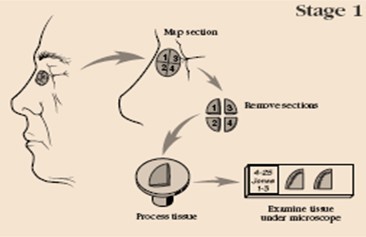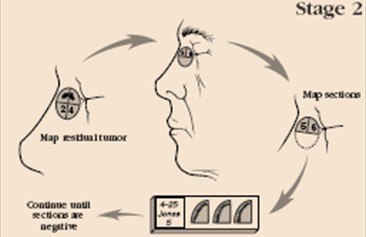Mohs Surgery
Skin cancer is very common-it is estimated that 50% of Americans with light colored skin will get at least one skin cancer in their lifetime. Sun exposure is felt to be the greatest causative agent, but heredity may play a role as well. There are several different types of skin cancer including basal cell carcinoma, squamous cell carcinoma and malignant melanoma. Various techniques are used to treat skin cancer including freezing, electrodessication and curettage, radiation, excision surgery and skin creams. Skin tumors often have deep extensions or “roots” that sometimes cause these treatments to fail.
What is Mohs Surgery?
Mohs surgery is a specialized, highly effective technique for removing skin cancers. It was developed in the 1930’s by Dr Frederick Mohs at University of Wisconsin and is now practiced throughout the world. Mohs surgery differs from other skin cancer treatments in that it permits the immediate and complete microscopic examination of the removed cancer tissue so that all roots and extensions of the cancer can be eliminated. Mohs surgery has the highest reported cure rate of all treatments for skin cancer. It is preformed in an outpatient setting, often in office, under local anesthesia.
Why Mohs?
Many skin cancers are often described as having “roots” that extend beyond the apparent borders of the visible tumor, by using this technique, the borders or margins are checked to remove these “roots”. This allows for the highest cure rate compared to all other techniques. Mohs surgery has a cure rate that approaches 99% for primary (never treated) basal cell cancers. For recurrent tumors, the cure rate is 95% (compared to only 80% with other modalities).
Is Mohs Right for Me?
If this is your first time having Mohs surgery, the doctor would like to meet with you prior to having the procedure done. This will allow Dr. Van Tuyl to examine your surgical site, obtain a medical history and determine whether the technique of Mohs would be the best treatment for you. It will also allow you to learn about the procedure and ask any questions you have.
How is Mohs Surgery Performed?

There are three steps involved in Mohs surgery:
- First the area is numbed around the tumor using local anesthesia to eliminate any pain. This usually stings for a few seconds and is usually the only pain felt throughout the whole procedure. A detailed diagram (a Mohs map) of the removed specimen is drawn. Then, the visible portion of the tumor is carefully removed using a scalpel or curette.
- The specimen is color coded to distinguish top from bottom and left from right. A technician freezes the tissue and removes very thin slices from the entire edge and undersurface. These slices are places on microscope slides and stained for examination under the microscope. This most time consuming part of the procedure, often requiring an hour or more to complete.
- This allows examination of the entire surgical margin of the removed tissue. That is, the entire undersurface and the complete edge of the specimen are examined (Stage 1). All microscope roots of the cancer can thus be precisely identified and pinpointed on the Mohs map.

If there is any tumor left in any section, another wider excision is made but only in that area that was mapped as positive,(Stage 2). In my hands this occurs less than 10-15% of the time, the greatest risk being in the region of the nose where skin sparing is essential.
If more cancer if sound on the microscopic slides, the Mohs map is utilzed to remove additional tissue only where cancer is present. Only tissue around the “roots” and extensions of cancer is removed. When the process reveals no tumor at any margin the procedure is over. Please plan on scheduling about 3-4 hours for the entire process.
Most wound are closed with stitches, very occasionally a rotation flap or skin graft is necessary but Dr Van Tuyl usually can forewarn you if a flap is needed prior to the procedure.
Preparation and Post-Op for Mohs Surgery
In general, you should treat your day of Mohs like any other day. Take all of the regular scheduled medicines but if you are taking blood thinners ask the doctor about those. The following medications should be discountined 10 days prior to surgery: Aspring containing products, Ibuprofen (Motrin), Vitamin E, Herbal medications and Persantine.
Post op care for Mohs
Use ice packs continuously for the first 24 hours, keep the wound dry. Suture removal will be done within 4-7 days after procedure. After the stitches are removed use polysporin ointment twice a day for seven days. You will need to apply steri strips after you have use the polysporin ointment until the skin is completely healed.
